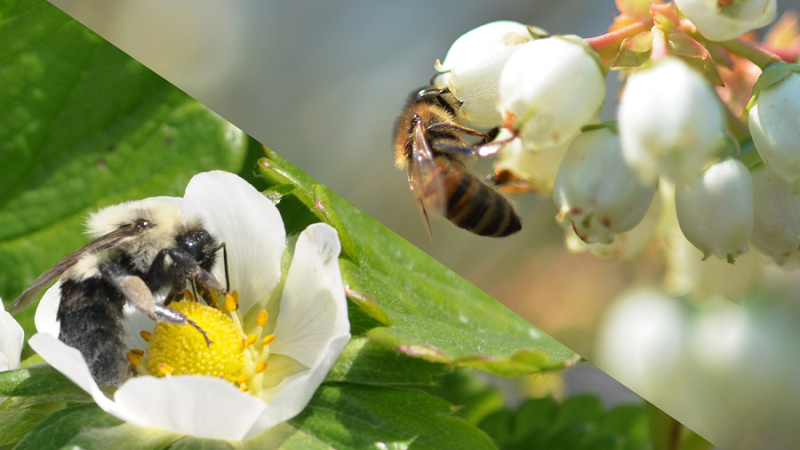How To Protect Young Walnut Trees

Rain in the fall following irrigation may have meant too much water for young walnut trees, resulting in damaged roots.
When an individual young walnut tree turns yellow compared to all of its neighbors it often indicates that there is something going wrong in the root system. There are a variety of potential causes for these symptoms and we can’t explore all of them fully here but we’ll try to comment on some of the main things we see on farm calls.
Water Logging
One of the more common problems has been water logging injury due to either excess irrigation or periods of excessive rainfall sometime during the past two years. When walnut roots are excessively wet they can die from lack of oxygen even without any major pathogens present. Rain during during the fall could have been a problem for some trees in young orchards that made good growth up the stake the first year, made good growth the second growing season, were pruned back last dormant season, But, either didn’t grow this past spring or made very weak growth the next year.
The rain in the fall following irrigation may have been too much water resulting in damaged roots. Dead roots were already decomposing from secondary fungi in July the next year while callus was growing along the edges of the sunken dead areas compared to live portions of the root. There was no phytophthora detected, only decay caused by secondary fungi.
Moisture Stress
Good irrigation management is required for walnut growth and vigor. Young walnut trees are very sensitive to moisture stress and will stop growing at relatively low stress levels. Root systems need to be kept moist but not wet enough to favor root rot fungi and/or low oxygen conditions. Pressure chambers are the most effective technique for measuring tree water status. Research suggests walnuts will slow shoot growth at –8 bars Midday Stem Water Potential. Soil augers are useful for visual soil moisture evaluation and various soil moisture sensors are available.
Be careful when using irrigation systems designed for mature orchards with large root systems where water placement is not as critical. Furrow or sprinkler water application may not always reach small root systems in young orchards resulting in tree stress and poor growth.
Soil-Borne Diseases
Diseases affecting crown and root systems of walnut trees include phytophthora root and crown rot, armillaria root, and crown rot and crown gall. Both phytophthora and armillaria cause similar above ground symptoms: poor terminal growth, small chlorotic leaves, premature defoliation, decreased productivity, dieback of terminal shoots, and subsequent collapse and death.
For phytophthora, disease severity depends upon phytophthora species, soil type, climatic conditions, and tree age. Phytophthora affects the inner bark and cambium, typically staining the wood and creating dead tissue (canker) that can extend above ground up the tree trunk. Black ooze from infected, decayed bark may be noticeable on either the English scion or the above ground portion of paradox rootstock. Removal of the outer bark reveals dead, brown tissue with a water soaked zonate appearance near the margin between healthy white and infected brown tissue if the fungus is active. Excessive soil moisture favors infection.
Armillaria or oakroot fungus is identified by removing dead bark from crown or root tissue and looking for creamy white, fan shaped fungal growths (plaques). These plaques are usually most abundant between the bark and woody tissue at the crown. The most reliable diagnosis is the presence of rhizomorphs which resemble brown to black shoestrings and are usually found adhering to the outer bark of roots. They develop best in moist soil. Armillaria may produce clusters of mushrooms around the base of infected trees following rainfall, usually from October to February.
Crown gall, caused by the bacterium A. tumefaciens is relatively easy to identify. Young galls are roundish “golf ball” shaped growths on root and/or crown tissue. Galls are made up of undifferentiated, disorganized soft spongy tissue. As galls enlarge, gall centers die, creating an open cavity. Galls most often develop on root or crown tissue underground and may not be noticed until they enlarge and push soil up around infected trees. Careful excavation using shovels, water or air jets will reveal crown gall infection. Crown gall infected trees will be stunted, demonstrate poor growth and yellow foliage depending upon how severely the gall encompasses the crown. Untreated galls can girdle the tree.
Nematodes
The four most common genera of nematodes found in walnut orchards are root lesion (Pratylenchus vulnus), ring (Criconemella spp.), root knot (Meloidogyne spp.), and dagger (Xiphinema spp.). Each nematode has its own method of infesting roots but they all damage root systems. Nematodes seldom kill trees, but they are tree stressors and act in conjunction with other stress factors to reduce growth and yield. Poor performing trees, particularly in replanted orchards without preplant soil fumigation, are good candidates for nematode damage. Walnut roots may exhibit dark elongated lesions on inner bark tissue or show knots or galls. A soil sample analyzed by a lab familiar with nematode identification can confirm an initial diagnosis.
Vertebrates
Rodents are potential pests in all orchards, but they are more likely to invade orchards next to rangeland or unmanaged areas. Voles, also called meadow voles or meadow mice, may move into walnut orchards and feed on the bark of young trees, particularly when vegetation around tree trunks offers cover and protection. Pocket gophers are potentially serious pests especially in young orchards. Girdling and root damage results in poor tree growth and tree death if severe. Look for parallel tooth marks at feeding sites on the wood.









